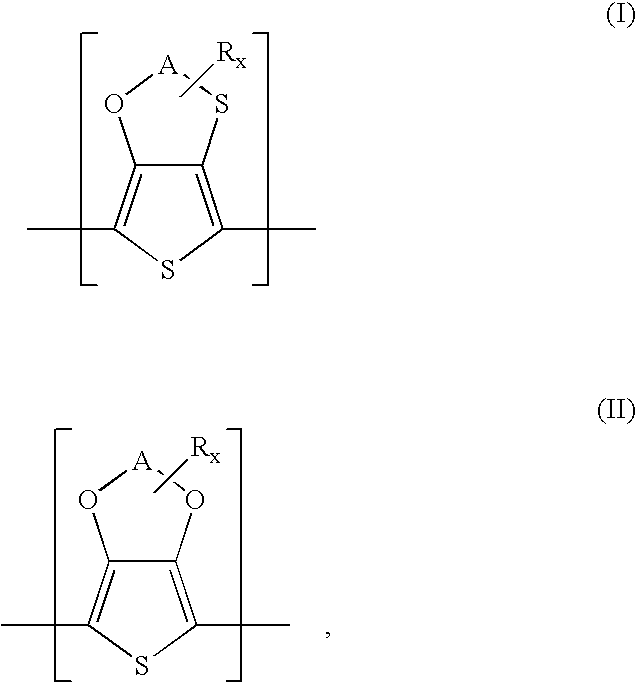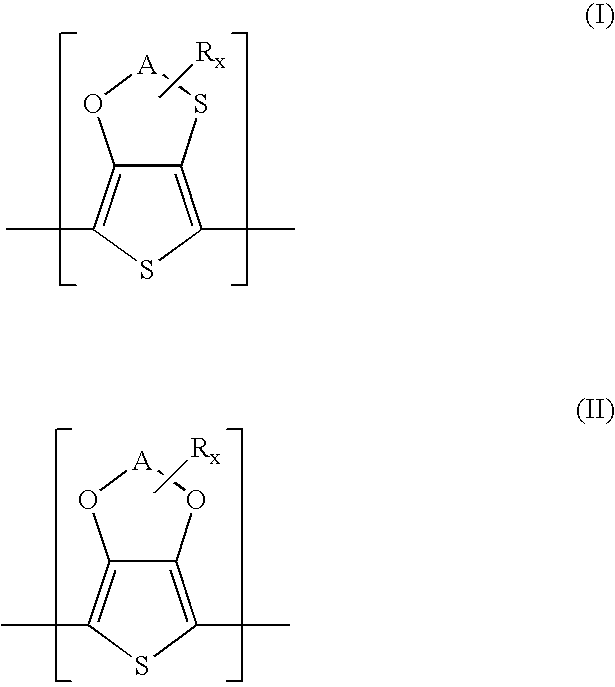Polythiophenes having alkyleneoxythia thiophene units in electrolyte capacitors
a technology of alkyleneoxythiathiophene and polythiophene, which is applied in the field of polythiophenes having alkyleneoxythiathiophene units in electrolyte capacitors, can solve the problems of high current loss, difficult preparation of 3,4-ethylenedithiathiophene, and restrict the practicability of this synthetic route and the use of the product, so as to reduce the polymerization potential
- Summary
- Abstract
- Description
- Claims
- Application Information
AI Technical Summary
Benefits of technology
Problems solved by technology
Method used
Image
Examples
example 1
Preparation of 3,4-ethyleneoxythiathiophene (thieno[3,4-b]-1,4-oxathiane)
[0169]
[0170]32.31 g (187.6 mmol) of 3,4-diethoxythiophene, 29.31 g (375.2 mmol) of 2-mercaptoethanol and 3.56 g (18.7 mmol) of p-toluenesulphonic acid monohydrate were heated to reflux under an N2 atmosphere in 400 ml of toluene for 5 h. In this time, toluene and ethanol formed were removed continuously and replaced by fresh toluene. Afterwards, the reaction was complete according to thin-film chromatography monitoring. The reaction mixture was filtered after cooling to room temperature (23° C.) and washed to neutrality with water. After drying over sodium sulphate, the mixture was distilled at 0.07 mbar (b.p. 59-62° C.) and the distillate was further purified by column chromatography on silica gel (eluent: toluene).
[0171]Yield: 15.99 g of thieno[3,4-b]-1,4-oxathiane (=53.9% of theory) as a virtually colourless oil
[0172]1H-NMR (400 MHz) δ(CDCl3, ppm): 6.72 (d, 1H, J=3.55 Hz), 6.46 (d, 1H, J=3.55 Hz), 4.37 (m, 2...
example 2
Preparation of methyl-3,4-ethylenedioxythiathiophene (2-methylthieno[3,4-b]-1,4-oxathiane)
[0173]
[0174]11.68 g (67.8 mmol) of 3,4-diethoxythiophene, 12.5 g (135.6 mmol) of 1-mercapto-2-propanol and 1.29 g (6.8 mmol) of p-toluenesulphonic acid monohydrate were heated to reflux under an N2 atmosphere in 200 ml of toluene for 10 h. The further workup was as described in Example 1.
[0175]Yield: 4.06 g of 2-methylthieno[3,4-b]-1,4-oxathiane (=34.8% of theory) as a yellowish oil
[0176]1H-NMR (400 MHz) δ(CDCl3, ppm): 6.72 (d, 1H, J=3.54 Hz), 6.44 (d, 1H, J=3.54 Hz), 4.33 (q and X part of ABX, 1H, JX,CH3=6.2 Hz, JAX=1.9 Hz, JBX=9.0 Hz), 2.89 (B part of ABX, 1H, JAB=13.1 Hz), 2.83 (A part of ABX, 1H, JAB=13.1 Hz), 1.45 (d, 3H, JX,CH3=6.2 Hz).
[0177]From a second, contaminated fraction, a further approx. 1.5 g of pure product could be obtained by column chromatography, overall pure yield 47.6% of theory.
example 3 (
Inventive)
Production of Inventive Capacitors Using poly(3,4-ethyleneoxythiathiophene) as the Solid Electrolyte
[0178]Tantalum powder having a specific capacity of 50 000 μFV / g was compressed to pellets and sintered in order to form a porous body having the dimensions 4 mm*3 mm*1.5 mm. The pellets (anodes) were anodized to 30 V in a phosphoric acid electrolyte.
[0179]A solution consisting of one part by weight of 3,4-ethyleneoxythiathiophene (thieno[3,4-b]-1,4-oxathiane from Example 1) and 20 parts by weight of a 40% by weight solution of iron(III) p-toluenesulphonate in ethanol (Baytron® C-E, H.C. Starck GmbH) was prepared.
[0180]The solution was used to impregnate the anode pellets. The anode pellets were impregnated in this solution and subsequently dried at room temperature for 30 min, at 50° C. for 15 min and at 150° C. for 15 min. After the heat treatment, the solution was polymerized in the pellets. Subsequently, the pellets were washed in water for 30 min. After the washing, the...
PUM
| Property | Measurement | Unit |
|---|---|---|
| temperatures | aaaaa | aaaaa |
| temperatures | aaaaa | aaaaa |
| temperatures | aaaaa | aaaaa |
Abstract
Description
Claims
Application Information
 Login to View More
Login to View More - R&D
- Intellectual Property
- Life Sciences
- Materials
- Tech Scout
- Unparalleled Data Quality
- Higher Quality Content
- 60% Fewer Hallucinations
Browse by: Latest US Patents, China's latest patents, Technical Efficacy Thesaurus, Application Domain, Technology Topic, Popular Technical Reports.
© 2025 PatSnap. All rights reserved.Legal|Privacy policy|Modern Slavery Act Transparency Statement|Sitemap|About US| Contact US: help@patsnap.com



